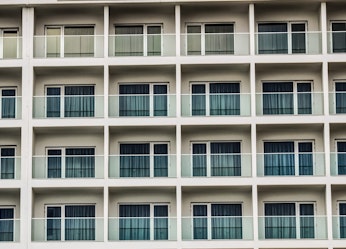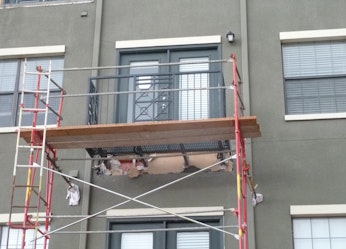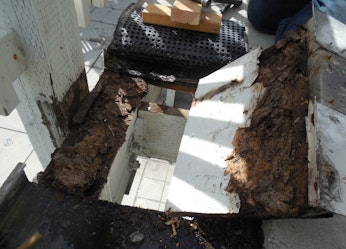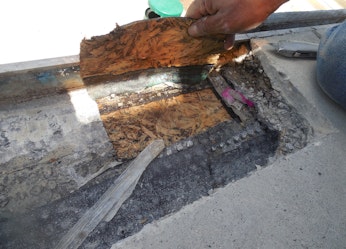

M|O Perspectives
Check back here for our thoughts on the latest developments in our industry.
Healthy balcony. Happy balcony.
Sep 17, 2018
Shortly after midnight on June 16, 2015 in Berkeley, California, three men and three women were killed when the balcony they were standing on collapsed. Seven others were injured and, ultimately, a multimillion-dollar lawsuit ensued and was settled by parties involved in the construction and management of the complex. The issues behind this catastrophic collapse are neither unique nor unpreventable.
We are all too familiar with the shortcomings of construction, especially as it relates to balconies and the tragic liabilities they can pose. In the course of our condition assessment work at Marx|Okubo we often find multifamily residential and commercial buildings with balconies that have serious condition issues requiring repair. In some cases, the deteriorated areas are serious enough that we may warn an owner to limit or avoid access or temporarily shore up a balcony until a problem is corrected. Obviously, this can make for an unhappy tenant.
Recent legislation underscores the importance of being proactive. Under the newly signed California Senate Bills 721 and 1465, the law will soon require the inspection of decks and balconies in multifamily dwellings and mandate repairs as necessary, as well as the reporting of certain settlements involving construction defects by involved parties.
Balcony issues can stem from many root sources. For example, problems can include bad drainage, deteriorated surface coatings, structural rot, damaged guardrails and other distress. Water intrusion—one of the triggers for deterioration—is not uncommon. And it’s important to understand that water can find its way into a balcony assembly in many ways.
Problems like this don’t appear magically. They develop over time. While these issues are more common in cooler and wet climates, they occur in warm dry areas as well. In a hot, dry climate it may take several years, but in the right conditions problems can appear quickly and require correction immediately.
Of course, the best way to avoid an expensive balcony repair is to implement good design practice, employ competent contractors during the construction process and perform necessary and thorough maintenance after the building is operational. While at first it may seem that all structures eventually fail, it’s important to know that leaks can be prevented, and structures can be preserved through a combination of thoughtful planning, good construction and consistent maintenance over the life of a property.
Here are a few things you can do to ensure that you have healthy balconies:
Design:
Open-vented configuration—While not always possible for aesthetic or fire rating reasons, exposed framing members with good airflow are more resilient and can withstand water exposure for longer periods.
Proper flashings—While good practice these days (not to mention, code compliance!) dictates the inclusion of flashings around penetrations and terminations, using the best possible materials in proper configurations will go a long way in avoiding headaches. In the scope of a total building budget, flashings are a minuscule part. Upgrading the specification on flashings to a better grade or extending them further along an edge is a very small budget item increase and always money well spent.
Adequate slope—The best kind of water is water that is moving away from and off of your buildings. One very simple way to ensure that is to design an adequate slope on horizontal surfaces. Flat or virtually-flat surfaces give the water time to find the weak points and penetrate your envelope.
Well-sized and redundant drainage—While it's good to have the water moving in the right direction, it is equally as important to ensure that drains are amply-sized and placed in multiple locations that do not rely on one drain alone to protect an area. Drains get clogged and a second location allows the building's maintenance staff time to make inspections and fix problems before tenants start calling.
Durable deck coatings—Deck coatings come in a variety of materials and thicknesses. When specifying a coating, the use of the surface should be realistically considered and an appropriate thickness selected. Areas around doors, high foot-traffic paths and auto zones should have increased system thickness for durability.
Sealed rail and trim anchorage—Water can penetrate even the tiniest gaps around rail and trim anchorage points. It is not enough to seal around the edges of openings. Redundant measures, such as self-healing flashings and setting anchors in sealant are required behind surfaces as well. This keeps any maintenance oversights in the future from turning into expensive budget bombs.
Construction:
Mockups—All buildings are prototypes. The best way to understand a structure or its embodied systems is to build it. Mockups are small sections of buildings built away from the final building that allow the constructors to work out the kinks and adjust the design to make the final construction watertight. If you don't have a mockup of your building's exterior and balcony construction in your budget, then you are likely going to learn the hard (and expensive) way that you’re only asking for trouble.
Construction inspection—An unfortunate reality is that not all construction is done perfectly. Whether due to unclear designs, untrained crews, tight schedules or inadequate supervision, things sometimes are not performed exactly the way the architects and engineers that designed them intended. Having a qualified, adequately-resourced firm review the project to ensure it’s conforming to intended design and construction is a great way to avoid future problems. Also, adequately structuring the inspection schedule and budget will catch problems before they become widespread.
Flood test—Water testing a balcony before residents or tenants move into a building is a good way to ensure that water is going to stay out of the interior. Some contractors test 100 percent of balconies to get a comfort level that a coating or system is going to hold up. While that may seem like overkill, it is crucial that at a minimum, flood testing is done on a high enough proportion of decks to validate the structural integrity.
Punch list—While most developers carefully check the residential or office area interiors before final acceptance of a newly constructed property, they often skim over balconies when investing a little more time and/or money could avoid big problems ahead. Slope, drain condition, railing anchorage and gap sizing sealants and other aspects should be carefully checked, and any unacceptable conditions recorded and communicated to the construction team. It only takes one failed rail or missing flashing to cause a condition that can be expensive or, worse, fatal.
Maintenance:
Adequate budgeting—Though construction can be expensive these days, maintenance is a far greater cost over the life of a building. Cutting maintenance to inadequate levels may feel necessary at times in constrained budgets, but that choice often comes back to haunt owners with repair or litigation costs that are multiples of what a well-maintained structure would cost.
Annual inspection program—Our theme here is that a small problem can become a large and expensive headache if not caught in time. Annual inspections of balconies, however, by building engineers or trained professionals can catch an issue before it becomes large.
Thorough follow up on tenant complaints—Building users and occupants are often the proverbial "canary in the coal mine" when it comes to balcony issues. Their complaints should be thoroughly checked out in a timely manner and issues corrected to maintain a watertight structure.
Coating renewals—Once you can see the concrete or wood under a coating, water is getting in. Renewing a deck coating on schedule and before it is visibly worn through is the best way to keep water out and avoid or minimize repair bills.
Aggressive crack repair—Even a tiny crack in concrete or a deck coating material can let in a lot of water. Regardless, cracks can be signs of a greater problem that, if left unrepaired, will cost many times the amount of the avoided initial correction needed.
Remember, whatever the cost of proper design, construction and maintenance, it is ALWAYS way less expensive than the cost of repair, tenant disruption and litigation. The best way to have a healthy, long-lasting balcony is to get the right people and firms involved in the design, construction and maintenance of your building to make sure your balconies are healthy and happy.
Marx|Okubo helps project teams at all stages of a building's lifespan by providing pre-construction plan reviews, construction observations or periodic maintenance reviews and troubleshooting. For more information contact sandy_blair@marxokubo.com.




What we do.
- Owner's Representation
- Property Condition Assessment
- Project Management
- Constructability Reviews
- Repair | Reconstruction
- Facility Condition Assessment
- Construction Loan Monitoring
- Accessibility
- Building Enclosure
- Fire | Life Safety
- Mechanical | Electrical | Plumbing
- ESG | Sustainability & Resiliency
- Structural Engineering
- ASAP® - Automated Structure Alert Program
Marx|Okubo is a national architecture/engineering/construction consulting firm that works with real estate owners, investors and lenders—at every point of the property lifecycle—to evaluate their building projects, solve complex challenges and implement tailored solutions. We help clients understand their projects’ complexities, so they can make more informed decisions and, ultimately, mitigate their risk.




